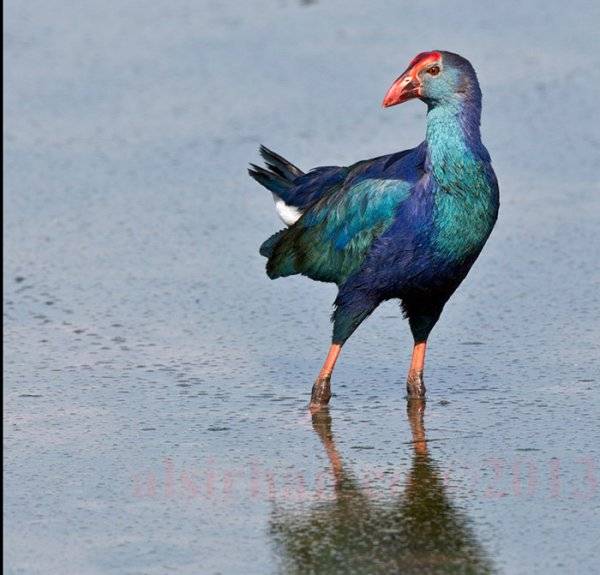OSME Region List version 3.2 – a precis of changes

There have been numerous taxonomic and related developments since v3.1.
- Several former Puffinus taxa have been transferred to a restored genus, Ardenna, making most groups monophyletic (Christides & Boles 2008).
- Purple Swamphen has been split (IOC5.3) pretty well as ORL3.1 had forecast.
- From the thesis of Cohen 2011, we have revised most of the Sandgrouse, enlarging Syrrhaptes at the expense of Pterocles, but Cohen 2011 did not sample all taxa, and so further revision may occur.
- Evidence has been advanced to elevate Cyprus Scops Owl to species rank (Robb & The Sound Approach 2015, Flint et al 2015).
- Desert Owl Strix hadorami (formerly Hume’s Owl S. butleri) and Omani Owl (now S. butleri, but applied to differing geographical population(s)) are now identified, but distributions in part or in toto are uncertain – some recently-found widely-separated individuals in Iran are the latter species (Nunes et al 2015, Musavi et al 2016), but birds in the Eastern province of Saudi Arabia have yet to be identified (Kirwan et al 2015, Robb et al 2015).
- There have been minor changes of sequence of genera and within genera throughout the ORL.
- Miles et al 2015 show that song and morphology allow discrimination of Grasshopper Warbler Locustella naevia into eastern (straminea) and western (naevia) groups; molecular studies are needed to test this approach.
- Mason & Taylor 2015 found little or no genetic differentiation between Redpoll Acanthis flammea populations worldwide.
- Kamp et al 2015 revealed a decline of 94% in Yellow-breasted Bunting Emberiza aureola populations since 1980.
- The long-awaited Robins and Chats book (Clement and Rose 2015: 25 years in the making) appeared to much acclaim, providing several insights into OSME Region species, especially distributions, and some taxonomic interest, although the taxonomy in places was dated.
- Golden Eagle Aquila chrysaetos populations may comprise at least two species (Nebel et al 2015), but the study’s low Nearctic sample sizes prevent definitive taxonomic conclusions. Interestingly, Palearctic populations appear to comprise northern and southern clades, with low gene-flow between them.
However, two non-taxonomic changes have added species to the ORL.
Firstly, the OSME Region, with the agreement of the African Bird Club and the Oriental Bird Club, has extended its deep-ocean area south to 10°S, the result being as shown on the OSME website Home page. ABC and OBC have undertaken to consider where their respective deep-ocean boundaries should be designated, tasks which incorporate the Atlantic, Pacific and East Siberian Arctic Oceans. Initially, the OSME Region deep-ocean boundaries are shown as Great Circle lines or approximations to keep the initial limits simple and straightforward, but once ABC and OBC have formed their own policies, the OSME deep-ocean boundaries may, through joint discussion, be amended in future. We carried out a literature search for older papers referable to OSME Region sea areas, including the extension, and consequently confirmed occurrences that previously had been merely suspected. Furthermore, we check regularly both the BirdLife Seabird Tracking database (http://seabirdtracking.org/mapper/) and the BirdLife Marine IBA Inventory (an amazingly detailed e-Atlas:http://maps.birdlife.org/marineIBAs/default.html), confirming additional species in the overall OSME sea area.
Secondly, many BirdLife Data Zone species distribution maps (http://www.birdlife.org/datazone/species) have been revised to show a much more nuanced distribution, especially because the maps incorporate splits BL have adopted via the Tobias et al 2010 (qv) criteria. For example, for high-altitude species, the shaded distribution does not include valleys. One consequence has been confirmation that some species do occur quite widely in eastern Afghanistan – see Orange Bullfinch Pyrrhula aurantiaca http://www.birdlife.org/datazone/species/factsheet/22720662.
Mike Blair February 2016
References
Christidis, L and WE Boles. 2008. Systematics
and Taxonomy of Australian Birds. CSIRO Publishing, Collingwood, VIC,
Australia.
Cohen, C. 2011. The phylogenetics, taxonomy and biogeography of
African arid zone terrestrial birds: the bustards (Otididae), sandgrouse
(Pteroclidae), coursers Glareolidae) and Stone Partridge (Ptilopachus). Thesis.
Univ. Cape Town.
Clement, P and C Rose. 2015. Robins
and Chats. Christopher Helm. London, UK.
Flint, PR, D Whaley, GM Kirwan, M Charalambides, M Schweizer and M Wink.
2015. Reprising the taxonomy of Cyprus Scops Owl Otus (scops)
cyprius, a neglected island endemic. Zootaxa 4040(3):
301-316.
Kamp, J, S Oppel, AA Ananin, YA Durnev, SN Gashev, N Hölzel, AL Mishchenko,
J Pessa, SM Smirenski, EG Strelnikov, S Timonen, K Wolanska and S Chan. 2015.
Global population collapse in a superabundant migratory bird and illegal
trapping in China. Cons. Biol. DOI: 10.1111/cobi.12537
Kirwan, GM, M Schweizer and JL Copete. 2015. Multiple lines
of evidence confirm that Hume’s Owl Strix butleri (A. O. Hume,
1878) is two species, with description of an unnamed species (Aves:
Non-Passeriformes: Strigidae). Zootaxa 3904 (1): 028–050.
Mason, NA and SA Taylor. 2015. Differentially expressed genes match
bill morphology and plumage despite largely undifferentiated genomes in a
Holarctic songbird. Mol. Ecol. doi: 10.1111/mec.13140
Miles, W, D Parnaby, B Rosser, J Moss and JM Collinson. 2015. ‘Eastern
Grasshopper Warbler’ on Fair Isle: new to Britain.Brit. Birds 108: 231-236.
Musavi, SM, A Khani, A Khaleghizadeh and M Robb. 2016. The first
confirmed records of Omani Owl Strix butleri (AO Hume, 1878)
(Aves: Strigidae) from Iran. Zool ME XX
Nebel, C, A Gamauf, E Haring, G Segelbacher, A Villers and FE Zachos.
2015. Mitochondrial DNA analysis reveals Holarctic homogeneity and a
distinct Mediterranean lineage in the Golden Eagle (Aquila chrysaetos). Biol.
J. Linn. Soc. June 2015: 1-13.
Robb, MS & the Sound Approach. 2015. Undiscovered Owls.
The Sound Approach. Poole, UK.
Robb, MS, G Sangster, M Aliabadian, AB van den Berg, M Constantine, M
Irestedt, A Khani, SB Musavi, JMG Nunes, MS Willson and AJ Walsh, 2015. The
rediscovery of Strix butleri (Hume, 1878) in Oman and Iran,
with molecular resolution of the identity of Strix omanensis.
bioRix preprint doi: http//dx.doi.org/10.1101/025122
